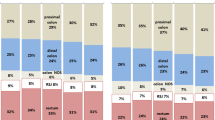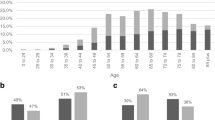Abstract
BACKGROUND: Because proximal colorectal cancers have a tendency to present at a more advanced stage and thus have a poorer prognosis, it is important to understand the factors associated with the development of proximal colorectal cancer. We hypothesized that older age, female gender, and the presence of comorbid illness would be associated with proximal cancers. METHODS: Incident cases of colorectal cancer (n=9,550) occurring in 1994 were identified from Florida's population-based statewide cancer registry. We categorized colorectal cancers as either proximal (cecum, ascending colon, and transverse colon) or distal (descending colon, sigmoid colon, rectosigmoid, and rectum). Multiple logistic regression analysis was used to determine the multivariable relationship between clinical characteristics and the odds of a proximal-occurring lesion. RESULTS: Four characteristics emerged as independent predictors of a proximal lesion. Each year of increasing age was associated with a 2.2 percent increase in the odds of a proximal lesion, whereas female gender was associated with a 38 percent increase in the odds of a proximal lesion. The presence of a comorbid condition was associated with a 28 percent greater odds of a proximal lesion, and, finally, black, non-Hispanic race was associated with a 24 percent greater odds of a proximal lesion. CONCLUSIONS: We found that increasing age, female gender, black, non-Hispanic race, and the presence of comorbid illnesses were factors associated with a greater likelihood of developing colorectal cancer in a proximal location. Further studies will be required to confirm these findings and to establish the mechanism by which comorbidity influences the site of colorectal cancer development.
Similar content being viewed by others
References
Greenlee RT, Murray T, Bolden S, Wingo PA. Cancer statistics, 2000. CA Cancer J Clin 2000;50:7–33.
Ries LA, Wingo PA, Miller DS,et al. The annual report to the nation on the status of cancer, 1973–1997, with a special section on colorectal cancer. Cancer 2000;88:2398–424.
Dinning JP, Hixson LJ, Clark LC. Prevalence of distal colonic neoplasia associated with proximal colon cancers. Arch Intern Med 1994;154:853–6.
Lemmel GT, Haseman JH, Rex DK, Rahmani E. Neoplasia distal to the splenic flexure in patients with proximal colon cancer. Gastrointest Endosc 1996;44:109–11.
Loffeld R, Putten A, Balk A. Changes in the localization of colorectal cancer: implications for clinical practice. J Gastroenterol Hepatol 1996;11:47–50.
Distler P, Holt PR. Are right- and left-sided colon neoplasms distinct tumors? Dig Dis 1997;15:302–11.
Jessup JM, McGinnis LS, Steele GD Jr, Menck HR, Winchester DR. The National Cancer Database. Report on colon cancer. Cancer 1996;78:918–26.
Coates RJ, Greenberg RS, Liu MT,et al. Anatomic site distribution of colon cancer by race and other colon cancer risk factors. Dis Colon Rectum 1995;38:42–50.
Devesa SS, Chow WH. Variation in colorectal cancer incidence in the United States by subsite of origin. Cancer 1993;71:3819–26.
Ikeda Y, Koyanagi N, Mori M,et al. Increased incidence of proximal colon cancer in the elderly. J Clin Gastroenterol 1996;23:105–8.
Slattery ML, Friedman GD, Potter JD, Edwards S, Caan BJ, Samowitz W. A description of age, sex, and site distributions of colon carcinoma in three geographic areas. Cancer 1996;78:1666–70.
Stewart RJ, Robson RA, Stewart AW, Stewart JM, Macbeth WA. Cancer of the large bowel in a defined population: Canterbury, New Zealand, 1970–1974. Br J Surg 1979;66:309–14.
Fleshner P, Slater G, Aufses AH Jr. Age and sex distribution of patients with colorectal cancer. Dis Colon Rectum 1989;32:107–11.
Thomas CR Jr, Jarosz R, Evans N. Racial differences in the anatomical distribution of colon cancer. Arch Surg 1992;127:1241–5.
Gapstur SM, Potter JD, Folsom AR. Alcohol consumption and colon and rectal cancer in postmenopausal women. Int J Epidemiol 1994;23:50–7.
Bufill J. Colorectal cancer: evidence for distinct genetic categories based on proximal or distal tumor location. Ann Intern Med 1990;113:779–88.
Slattery ML, Potter JD, Coates A,et al. Plant foods and colon cancer: an assessment of specific foods and their related nutrients (United States). Cancer Causes Control 1997;8:575–90.
Hebert-Croteau N. A meta-analysis of hormone replacement therapy and colon cancer in women. Cancer Epidemiol Biomarkers Prev 1998;7:653–9.
Hu FB, Manson JE, Liu S,et al. Prospective study of adult onset diabetes mellitus (type 2) and risk of colorectal cancer in women. J Natl Cancer Inst 1999;91:542–7.
He J, Klag MJ, Caballero B, Appel LJ, Charleston J, Whelton PK. Plasma insulin levels and incidence of hypertension in African Americans and whites. Arch Intern Med 1999;159:498–503.
Salonen JT, Lakka TA, Lakka HM, Valkonen VP, Everson SA, Kaplan GA. Hyperinsulinemia is associated with the incidence of hypertension and dyslipidemia in middle-aged men. Diabetes 1998;47:270–5.
Pyorala M, Miettinen H, Laakso M, Pyorala K. Hyperinsulinemia predicts coronary heart disease risk in healthy middle-aged men: the 22-year follow-up results of the Helsinki Policemen Study. Circulation 1998;98:398–404.
Slattery ML, Boucher KM, Caan BJ, Potter JD, Ma KN. Eating patterns and risk of colon cancer. Am J Epidemiol 1998;148:4–16.
Steinmetz KA, Potter JD. Food-group consumption and colon cancer in the Adelaide Case-Control Study II. Meat, poultry, seafood, dairy foods and eggs. Int J Cancer 1993;53:720–7.
Steinmetz KA, Potter JD. Egg consumption and cancer of the colon and rectum. Eur J Cancer Prev 1994;3:237–45.
Giovannucci E, Willett WC. Dietary factors and risk of colon cancer. Ann Med 1994;26:443–52.
Kiefe CI, Funkhouser E, Fouad MN, May DS. Chronic disease as a barrier to breast and cervical cancer screening. J Gen Intern Med 1998;13:357–65.
Yancik R, Wesley MN, Ries LA,et al. Comorbidity and age as predictors of risk for early mortality of male and female colon carcinoma patients: a population-based study. Cancer 1998;82:2123–34.
Payne JE, Chapuis PH, Pheils MT. Surgery for large bowel cancer in people aged 75 years and older. Dis Colon Rectum 1986;29:733–7.
Havlik RJ, Yancik R, Long S, Ries L, Edwards B. The National Institute on Aging and the National Cancer Institute SEER collaborative study on comorbidity and early diagnosis of cancer in the elderly. Cancer 1994;74(Suppl):2101–6.
Laish-Vaturi A, Gutman H. Cancer of the anus (review). Oncol Rep 1998;5:1525–9.
Ayanian J, Kohler B, Abe T, Epstein A. The relation between health insurance coverage and clinical outcomes among women with breast cancer. N Engl J Med 1993;329:326–31.
Diez-Roux AV. Bringing context back into epidemiology: variables and fallacies in multilevel analysis. Am J Public Health 1998;88:216–22.
Hofer T, Wolfe R, Tedeschi P, McMahon L, Griffith J. Use of community versus individual socioeconomic data predicting variation in hospital use. Health Serv Res 1998;33:243–59.
Krieger N. Overcoming the absence of socioeconomic data in medical records: validation and application of a census-based methodology. Am J Public Health 1992;87:703–10.
Krieger N, Fee E. Social class: the missing link in U.S. health data. Int J Health Serv 1994;24:25–44.
Shambaugh E, Weiss M. Summary staging guide: cancer surveillance epidemiology and end results reporting. DHHS Publ. No. 86-2313. 1977.
Deyo R, Cherkin D, Ciol M. Adapting a clinical comorbidity index for use with ICD-9-CM administrative databases. J Clin Epidemiol 1992;45:613–9.
Charlson ME, Pompei P, Ales KL, MacKenzie CR. A new method of classifying prognostic comorbidity in longitudinal studies: development and validation. J Chronic Dis 1987;40:373–83.
Hosmer D, Lemeshow S. Applied logistic regression. New York: John Wiley & Sons, 1989.
Cohen A, Shank B, Friedman M. Colorectal cancer. In: DeVita VT Jr, Hellman S, Rosenberg SA, eds. Cancer: principles and practice of oncology. 3rd ed. Philadelphia: JB Lippincott, 1989:895–964.
Stange K, Flocke S, Goodwin M. Opportunistic preventive services delivery. J Fam Pract 1998;46:419–24.
Grady K, Lemkau JP, McVay JM, Reisine ST. The importance of physician encouragement in breast cancer screening of older women. Prev Med 1992;21:766–80.
Bostick R, Sprafka JM, Virnig BA, Potter JD. Predictors of cancer prevention attitudes and participation in cancer screening examinations. Prev Med 1994;23:816–26.
Chao A, Paganini-Hill A, Ross RK, Henderson BE. Use of preventive care by the elderly. Prev Med 1987;16:710–22.
McMichael AJ, Potter JD. Diet and colon cancer: integration of the descriptive, analytic, and metabolic epidemiology. Natl Cancer Inst Monogr 1985;69:223–8.
Leduc BE, Giasson M, Favreau-Ethier M, Lepage Y. Colonic transit time after spinal cord injury. J Spinal Cord Med 1997;20:416–21.
Fried DA, Voegele LD. Cardiac constipation. J S C Med Assoc 1997;93:221–2.
Galati JS, Holdeman KP, Bottjen PL, Quigley EM. Gastric emptying and orocecal transit in portal hypertension and end-stage chronic liver disease. Liver Transpl Surg 1997;3:34–8.
Gorard DA, Gomborone JE, Libby GW, Farthing MJ. Intestinal transit in anxiety and depression. Gut 1996;39:551–5.
Rosa-e-Silva L, Troncon LE, Oliveira RB, Foss MC, Braga FJ, Gallo L. Rapid distal small bowel transit associated with sympathetic denervation in type I diabetes mellitus. Gut 1996;39:748–56.
Zimmermann T, Laufen H, Yeates R, Scharpf F, Riedel KD, Schumacher T. The pharmacokinetics of extended-release formulations of calcium antagonists and of amlodipine in subjects with different gastrointestinal transit times. J Clin Pharmacol 1999;39:1021–31.
Levein NG, Thorn SE, Wattwil M. Dopamine delays gastric emptying and prolongs orocaecal transit time in volunteers. Eur J Anaesthesiol 1999;16:246–50.
Mann NS, Shinkle JM. Effect of clonidine on gastrointestinal transit time. Hepatogastroenterology 1998;45:1023–5.
Brogna A, Ferrara R, Bucceri AM, Lanteri E, Catalano F. Influence of aging on gastrointestinal transit time. An ultrasonographic and radiologic study. Invest Radiol 1999;34:357–9.
Evans JM, Fleming KC, Talley NJ, Schleck CO, Zinmeister AR, Melton LJ. Relation of colonic transit to functional bowel disease in older people: a population-based study. J Am Geriatr Soc 1998;46:83–7.
Paganini-Hill A. Estrogen replacement therapy and colorectal cancer risk in elderly women. Dis Colon Rectum 1999;42:1300–5.
Van Gorkom BA, Cats A, Van der Meer R,et al. Effects of hemicolectomy on bile acid metabolism in relation to colon carcinogenesis in man. Eur J Clin Invest 1997;27:589–94.
Cordice JW Jr, Johnson H Jr. Anatomic distribution of colonic cancers in middle-class black Americans. J Natl Med Assoc 1991;83:730–2.
Rochon P, Katz J, Morrow L,et al. Comorbid illness is associated with survival and length of hospital stay in patients with chronic disability: a prospective comparison of three comorbidity indices. Med Care 1996;34:1093–101.
Krousel-Wood MA, Abdoh A, Re R. Comparing comorbid-illness indices assessing outcome variation: the case of prostatectomy. J Gen Intern Med 1996;11:32–8.
Author information
Authors and Affiliations
Additional information
Dr. Roetzheim was supported through the Generalist Physician Faculty Scholars Awards from the Robert Wood Johnson Foundation.
About this article
Cite this article
Gonzalez, E.C., Roetzheim, R.G., Ferrante, J.M. et al. Predictors of proximalvs. distal colorectal cancers. Dis Colon Rectum 44, 251–258 (2001). https://doi.org/10.1007/BF02234301
Issue Date:
DOI: https://doi.org/10.1007/BF02234301




